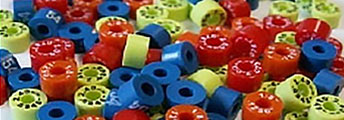Choosing the Right Thickness and Copper Weight for Your FR4 PCB - A No-Nonsense Guide
Smarter Choices for FR4 Copper Clad Laminate Specifications
In the fast-paced world of electronics design, even the most brilliant circuit can fall short if the physical foundation isn't right. Engineers at Midwest Circuit Technology often notice that board thickness and copper weight decisions get pushed to the last minute – yet these specifications can determine whether an aerospace control system functions flawlessly or a medical device prototype meets regulatory requirements.
After supplying precision tools for nearly two decades, MCT has worked with countless engineers who discovered that these seemingly mundane specifications have outsized impacts on performance, manufacturability, and reliability. One aerospace customer spent months troubleshooting signal integrity issues before realizing their ultra-thin traces on standard-weight copper were creating impedance problems that rippled throughout their system.
This guide explores how to make smarter choices about FR4 copper clad laminate specifications so the next project – whether it's telecommunications infrastructure or next-generation automotive systems – performs exactly as intended from the first prototype.
FR4 Basics: Not All Boards Are Created Equal
FR4 has been the industry's go-to material since the 1970s. It's the reliable, widely available option that gets the job done for most applications. This fiberglass-reinforced epoxy laminate serves as the backbone of most PCBs found everywhere, from smart home devices to satellite components.
The term "FR4" refers more to a category than a specific material. It's similar to how "SUV" describes a type of vehicle, but a Honda CR-V and a Range Rover offer very different experiences despite both being SUVs.
Thickness Matters: Finding Your Board's Sweet Spot
When it comes to FR4 copper clad laminate thickness, the most common options range from ultra-thin 0.4mm boards to robust 3.2mm options. The standard 1.6mm (1/16") thickness works for most applications but isn't ideal for every situation.
When to Go Thinner (0.4mm - 1.0mm):
- Devices with strict size and weight constraints like wearables and smartphones
- Flex-rigid designs that require thinner rigid sections
- Applications with extremely tight form factor requirements
- Rapid prototyping with LPKF or T-Tech PCB prototyping tools
When to Go Standard (1.6mm):
- General-purpose applications without special requirements
- Consumer electronics and standard industrial controls
- Designs without specific mechanical constraints
- Projects requiring straightforward manufacturing processes
When to Go Thicker (2.0mm - 3.2mm):
- Applications requiring exceptional mechanical rigidity
- Boards supporting heavy components that might cause warping
- Environments with high mechanical stress
- High voltage designs needing additional isolation
A real-world example comes from a client designing charging stations for electric vehicles. Their initial prototype used standard 1.6mm boards but experienced warping under the weight of the power components. Switching to 2.4mm solved the problem immediately. The extra thickness added some cost but saved thousands in potential warranty claims.
Copper Weight: The Power-Handling Puzzle
Copper weight (or thickness) is measured in ounces, referring to the weight of copper per square foot. This unique measurement is standard in the industry despite its unusual nature.
Most designs use 1oz copper, but different applications may require alternatives:
Lightweight Copper (0.5oz):
- Designs with ultra-fine traces and spaces
- High-frequency applications where signal integrity is critical
- Prototyping with T-Tech or LPKF systems where thinner copper is easier to mill
Standard Copper (1oz):
- Most general-purpose applications
- Good balance between conductivity and etching precision
- Compatible with standard PCB prototyping tools
Heavy Copper (2oz, 3oz, or more):
- Applications handling significant power or current
- Designs requiring improved heat dissipation
- Boards needing increased mechanical strength for connectors
- Projects involving plated through holes that require extra durability
A notable failure case involved a power supply design that specified 1oz copper for traces carrying over 10 amps. The traces literally melted during a critical demonstration for a potential client, highlighting the importance of proper copper weight selection.
The Thickness-Copper Relationship: Finding Balance
An important consideration is that thickness and copper weight affect each other. Increasing copper weight also adds to the overall thickness of the board. This relationship can impact tight mechanical tolerances if not properly accounted for in the design.
For high-precision work using PCB prototyping tools like those from LPKF or T-Tech, this relationship becomes even more important. A 1.6mm FR4 copper clad laminate with 2oz copper will have different milling characteristics than the same thickness with 0.5oz copper.
Practical Tips From the Trenches
- Order samples before committing to a full production run when trying new specifications
- Consider temperature - thicker boards handle heat better than thin ones
- Remember impedance control - thickness and copper weight will affect impedance calculations
- Avoid over-engineering - heavier/thicker isn't always better, just more expensive
- Test with prototyping equipment - ensure LPKF or T-Tech systems are properly set up for the chosen material
Making the Final Call
The right FR4 copper clad laminate specifications ultimately depend on balancing:
- Electrical requirements
- Mechanical needs
- Manufacturing capabilities
- Budget constraints
When uncertain, standard 1.6mm with 1oz copper satisfies most requirements, even if it's not perfectly optimized for specific applications.
For guidance on material selection for upcoming projects, Midwest Circuit Technology offers consultation based on nearly two decades of experience supplying precision tools for the PCB industry.
The seemingly mundane decisions about material specifications often have the most significant impact on a project's success or failure.
Midwest Circuit Technology (MCT) offers a complete range of PCB prototyping tools for systems like LPKF and T-Tech, along with precision cutting tools for all FR4 copper clad laminate needs. Visit mctinfo.net to explore the full catalog.
